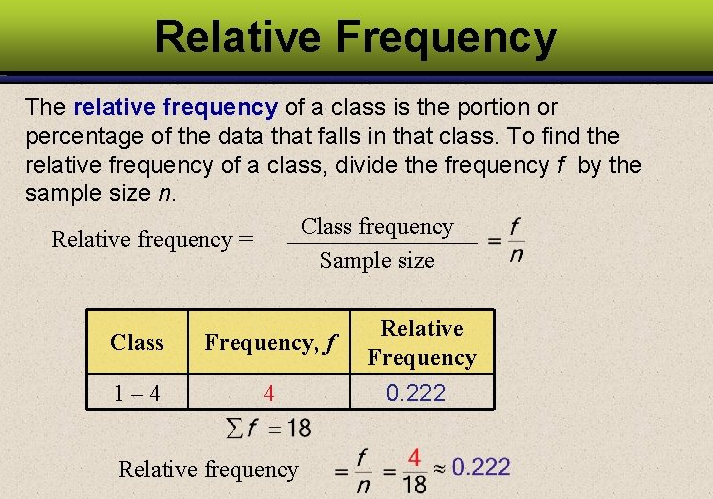When the word ‘relative’ is used, it means that something is being viewed in relation to or in proportion to another. An event’s frequency can be measured by measuring how often it occurs.
On the other hand, relative frequency measures how often a particular event occurs relative to its total occurrences. Let’s look at some examples of the relative frequency formula.

Table of Contents
What Is the Relative Frequency Formula?
In general, relative frequency is defined as the number of times an event occurs divided by the total number of events in a given scenario.
In order to calculate the relative frequency, two things must be known:
- Number of total events/trials
- Frequency count for a category/subgroup
The relative frequency formula can be given as follows:
Relative Frequency = Subgroup frequency/ Total frequency
Or
Relative Frequency = f/ n
Where,
- f is the number of times the data occurred in an observation
- n = total frequencies
Solved Examples Using Relative Frequency Formula
Example: A cubical die is tossed 30 times and lands 5 times on the number 6. What is the relative frequency of the die landing on the number 6?
Solution: The number of times a die is tossed = 30
Number of successful trials of getting number 6 = 5
By the formula, we know,
Relative frequency = Number of positive trials/Total number of trials
f = 5/ 30 = 16.66%
Answer: 16.66% of the time the die lands on the number 6.
Example: When a coin is flipped 100 times, it lands on heads 48 times. What is the relative frequency of the coin landing on tails?
Solution: Relative frequency = number of times an event has occurred / number of trials
The event in consideration is the coin landing on tails = 100 – 48 = 52 times
Relative frequency of the coin landing on tails = 52/100 = 0.52 = 52%
Answer: Relative frequency of the coin landing on tails is 52%.
FAQs
A relative frequency is the number of times an event occurs divided by the total number of events that occur in a given situation. A relative frequency formula is given as Relative Frequency = Subgroup frequency/Total frequency.
The difference between frequency and relative frequency is that frequency is based on the actual values of each class in a statistical dataset. The relative frequency, on the other hand, compares the individual values to the totals of all the classes in a set.
The relative frequency is calculated on the basis of the experimental results. A probability is a number between 0 and 1.0 that indicates the likelihood of an event. Probability can be defined as the number of times an event occurs divided by the number of opportunities to occur. In this case, the result is called the “relative frequency” of the event.
An event’s relative frequency is determined by the number of times it occurs out of the total number of events. It can be expressed as a proportion. The percentage is also sometimes used.
